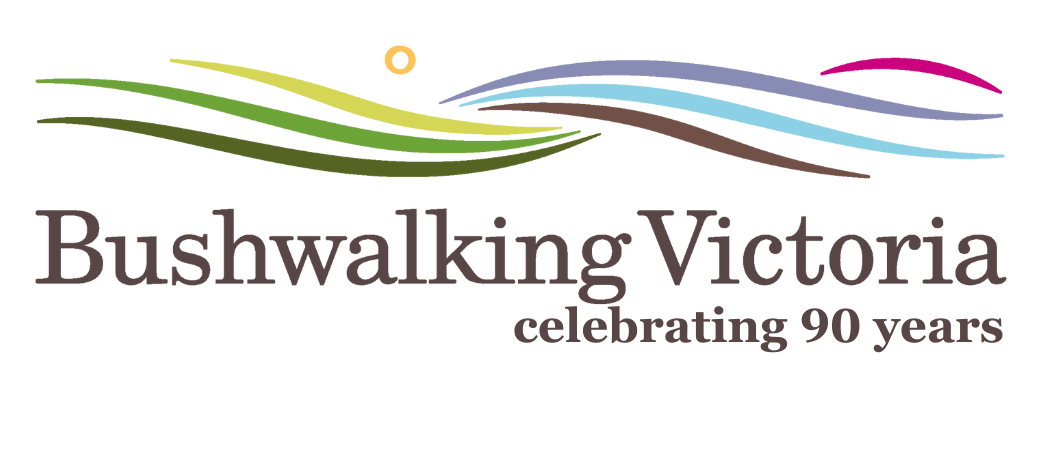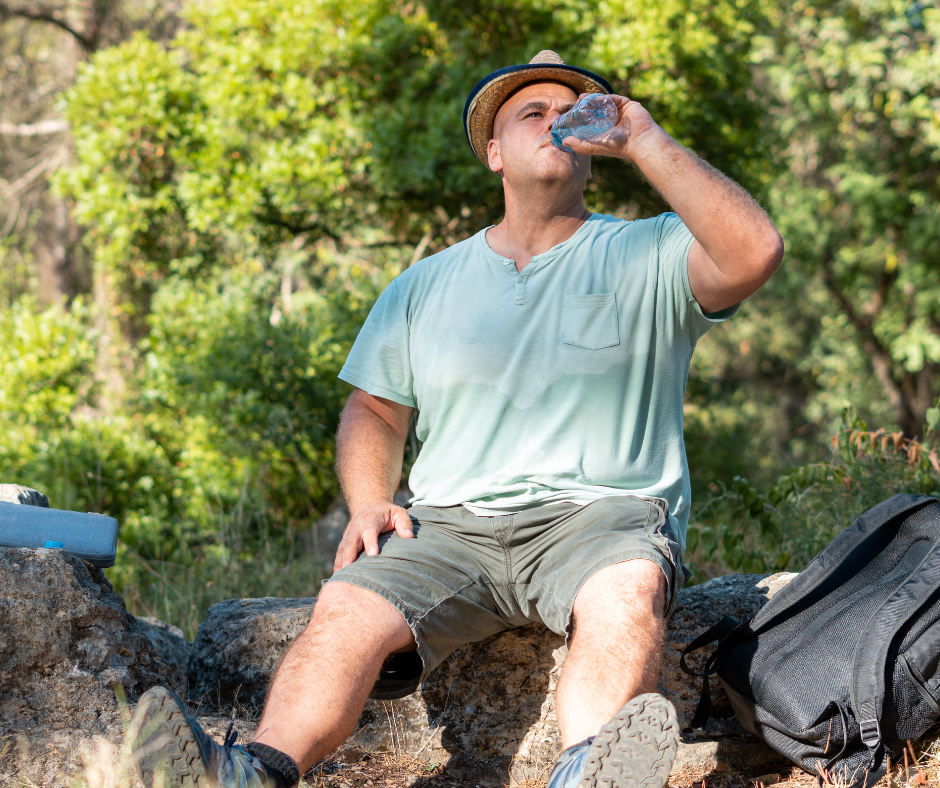
Author’s note: As in all cases to do with your body, please seek medical advice if you are unsure about any of the points raised in this article. You and your doctor must be the best judge of what is right for you.
Here is a link to ‘healthdirect’ Drinking water and your health for a health directed site on water consumption.
We frequently hear that on average, we should drink 8 glasses of water daily. This equates to about 2 litres or half a gallon and is commonly known as the “8×8” rule.
Body Size and Weight
However, when we consider the size, weight, activity level and other factors, the 8×8 rule is only a starting point regarding our daily water intake. Larger individuals will typically require more water than smaller individuals.
Activity Level, Climate and Environmental Considerations.
If you are physically active or engage in strenuous exercise, you’ll need to replenish fluids lost through sweating. In these cases, you may need to drink more than the standard recommendation. Similarly, if the weather is hot and humid, it can increase sweat production and fluid loss, requiring higher water intake to stay hydrated. High altitudes can also increase water needs.
Medical Conditions
Certain medical conditions, such as fever, diarrhea, or urinary tract infections, can increase fluid loss and necessitate higher water intake. Consult with a healthcare professional if you have specific health concerns.
Listen to Your Body
Thirst is a reliable indicator of your body’s need for water. If you feel thirsty, it’s a sign that you should drink more water.
It’s essential to listen to your body and drink water when you feel thirsty. You can monitor the colour of your urine as a general indicator of hydration. Pale yellow urine usually indicates adequate hydration, while dark yellow or amber urine may indicate dehydration.
Ultimately, there is no one-size-fits-all answer to how much water you should drink in a day, but staying hydrated by drinking water regularly throughout the day is crucial for overall health and well-being. As I am writing this article, I have a bottle of water beside me and remember occasionally to take a sip or two. Drinking a lot of water has never been a strong point for me.
How does water affect our enjoyment of hiking?
Are you taking part in a medium-hard 17-kilometre hike on a hot and humid day? If yes, then 2 litres might not be enough for you, particularly if you are one of those more generously proportioned persons.
Those who attended the social last Thursday when Graeme Barry talked about his Japanese hiking tour last September will remember photos of clothing that looked as if it had been taken out of the river. The weather was hot and humid, and both walkers were tall, one being six foot four inches in height. Two litres each would have been nowhere near sufficient to keep them both adequately hydrated.
Can one drink too much water?
Yes, it is possible to drink too much water. Please check out this link to give you a more in-depth overview of the possible problems associated with drinking too much water in a day. Overhydration: Types, Symptoms, and Treatments (healthline.com). Also, these two YouTube videos on the subject.
My experience of drinking too much water
About a decade ago, when on a mock-deployment with the Fire Brigade Task Force with our search and rescue dog group, I had a novel water drinking experience. It was hot. I drank and drank and drank, losing sight of how many bottles of water I had consumed over the course of the day. I knew all was not well when I realised, I was neither sweating nor peeing and had developed a headache. I wondered where all that water had gone. The paramedic immediately made me consume electrolytes and monitored me. This was a salutary lesson on the finer details of consumer water.
Here are some situations where drinking too much water can become a concern:
- Excessive Fluid Intake: Drinking an excessive amount of water in a short period, especially if done rapidly, can overwhelm the kidneys’ ability to excrete it.
- Endurance Events: Athletes taking part in prolonged endurance events, such as marathons or ultramarathons, may be at increased risk because of excessive sweating and high water intake without adequate electrolyte replacement.
- Psychological Conditions: Some individuals with certain psychological conditions, such as polydipsia (excessive thirst), may consume large quantities of water, leading to water intoxication.
Symptoms of water intoxication can vary but may include nausea, vomiting, headache, confusion, seizures, and in severe cases, coma or death. Treatment typically involves limiting water intake and, in severe cases, administering electrolytes intravenously.
For most people, maintaining a balanced intake of water throughout the day and drinking when thirsty suffices to stay hydrated without the risk of overhydration. It’s also essential to consider electrolyte balance, especially during prolonged physical activity or in hot conditions, by consuming fluids that contain electrolytes or by eating foods rich in electrolytes. If you have concerns about your fluid intake or experience symptoms of water intoxication, it’s important to seek medical attention promptly.
What will you carry your water in?
So, when you plan your walk, you will also consider in what kind of container you will carry your water. Today, our two most popular options are water bottles or water bladders, each with its advantages and disadvantages.
Let’s consider both options more closely.
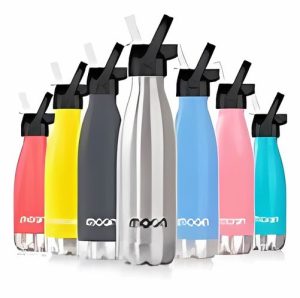
They are simple little creatures, straightforward and easy to use. But when we examine them more closely, we discover they are not that simple after all.
Made from durable materials such as stainless steel, aluminium, or BPA-free plastics, they are sturdy and can cope with a lot of wear and tear.
They usually vary between 20 to 25 centimetres tall with a 600 ml capacity but can be larger or smaller. They fit comfortably in most standard-sized backpack pockets. Their ergonomic grip makes them easy to handle.
A secure screw-on or press-on cap makes a tight seal, preventing leaks and spills. The cap may feature a built-in loop or carabiner clip to attach to backpacks or belts, making for easy access.
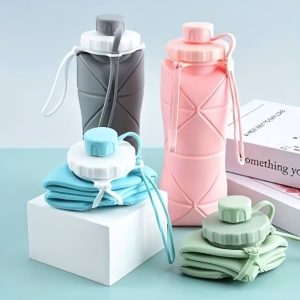
Inside the water bottles, a food-grade silicone lining provides an additional layer of leak-proof protection, stopping liquids from seeping or dripping and ensuring that your backpack won’t be a damp mess or you’ll have soggy sandwiches.
The mouthpiece
The mouthpiece can be simple or complex and depends on your preference. For added convenience, many water bottles come equipped with integrated features such as flip-top spouts, straw lids, or removable infusers for fruit infusion, allowing you to customise your hydration experience according to preference.
In summary, the water bottle combines practical functionality with stylish design, offering a reliable and eco-friendly solution for staying hydrated on the go.
I have found that the pull-up mouthpiece is a dirt trap and requires some careful cleaning with a suitable brush. Also, the inside bottom of the bottle will gather dirt and requires regular cleaning with a brush. Wrapping a clean tea towel around the handle of a wooden spoon and pushing it through to the bottom of the bottle is another way of cleaning it.
Best Water Bottles for Hiking and Travelling
Water bottles can be quite pricy when they come with filtration systems. 14 Best Filtered Water Bottles for Hiking and Traveling – Your Destination is Everywhere
Here is a range of non-filtered water bottles, also very pricy. Our 10 Best Water Bottles in Australia – February 2024 | BestProductsAustralia.com.
And then there are the ordinary, garden variety of bottles available from the supermarket, Reject Shop, Spotlight, and stores like Anaconda. There is something for every budget.
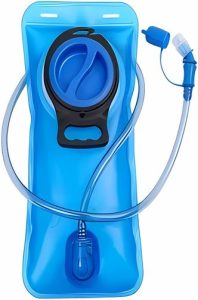
Water bladders can be an excellent alternative to water bottles on a hike. Here are some excellent reasons to consider them for your next walk if you have not yet explored bladders instead of bottles.
- Capacity: Water bladders often have larger capacities compared to water bottles, allowing you to carry more water without taking up additional space in your pack. Sizes start from 1 litre to 3 litre capacity.
- Hands-Free Hydration: Water bladders are typically equipped with a hose and bite valve, allowing you to drink without having to stop and take off your pack. This hands-free hydration can be especially convenient while hiking or engaging in other activities.
- Weight Distribution: Water bladders fit inside a backpack, distributing the weight of the water more evenly across your back, which can help with balance and comfort, especially on longer hikes.
- Space Efficiency: Since water bladders conform to the shape of your pack, they may be more space-efficient than water bottles, especially in packs with limited storage space.
- Insulation: Some water bladders come with insulation to help keep your water cool, which can be beneficial in hot weather or during long hikes.
- Available as a bladder to insert into your backpack, or as a specially designed backpack with a bladder like the Camelbak.
Considerations:
- Preference: Ultimately, the choice between water bottles and water bladders often comes down to preference and the specific needs of your hiking trip. Some people prefer the simplicity and durability of water bottles, while others appreciate the convenience and hands-free hydration offered by water bladders.
- And some people have both.
- Cost: Water bottles are generally less expensive than water bladders, although there are high-end options available for both.
- Maintenance: Water bladders require more maintenance to prevent mould and bacteria growth, as they are more difficult to clean thoroughly compared to water bottles. Special brushes and cleaning tablets are often used for this purpose.
- This is the type of cleaning kit readily available online from Amazon AU, eBay AU, and outdoor gear stores.

In summary, both water bottles and water bladders have their own advantages and disadvantages, and the best choice for you will depend on your personal preferences, the length of your hike and other factors such as pack space and hydration needs. Some hikers even choose to use a combination of both, carrying a water bottle for quick access and a water bladder for larger capacity and hands-free hydration.
